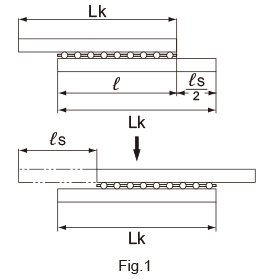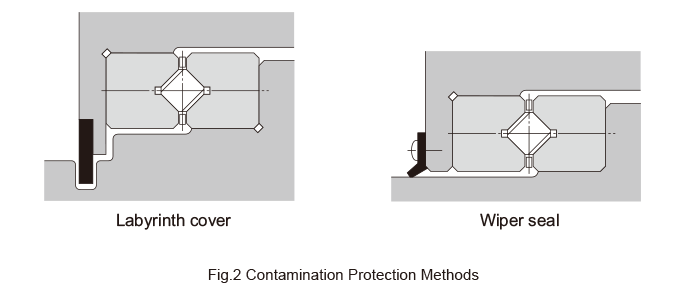Cross-Roller Guide/Ball Guide Precautions on Use
Handling
- Do not disassemble the parts. This will result in loss of functionality.
- Take care not to drop or strike the Cross-Roller Guide/Ball Guide. Doing so may cause injury or damage. Giving an impact to it could also cause damage to its function even if the product looks intact.
- When handling the product, wear protective gloves, safety shoes, etc., as necessary to ensure safety.
Precautions on Use
- Prevent foreign material, such as cutting chips or coolant, from entering the product. Failure to do so may cause damage.
- If the product is used in an environment where cutting chips, corrosive solvents, water, etc., may enter the product, use bellows, covers, etc., to prevent them from entering the product.
- If foreign material such as cutting chips adheres to the product, replenish the lubricant after cleaning the product.
- Do not use the product at temperature of 100℃ or higher.
- Micro-strokes tend to obstruct oil fi lm to form on the raceway in contact with the rolling element, and may lead to fretting corrosion. Take consideration using grease offering excellent fretting prevention. THK also recommends periodically executing a full stroke with the unit to ensure that the raceway and balls are coated with lubricant.
- Do not use undue force when fitting parts (pin, key, etc.) to the product. This may generate permanent deformation on the raceway, leading to loss of functionality.
- Using the product with some of the rolling elements missing may cause damage at an early stage.
- If any of the rolling elements falls, contact THK instead of using the product.
- Insufficient rigidity or accuracy of mounting members causes the bearing load to concentrate on one point and the bearing performance will drop significantly. Accordingly, give sufficient consideration to the rigidity/accuracy of the housing and base and strength of the fixing bolts.
Lubrication
- Thoroughly wipe off anti-rust oil and feed lubricant before using the product.
- When lubricating the product, apply grease directly on the raceway and stroke the product several times to let the grease spread inside.
- Do not mix different lubricants. Mixing greases using the same type of thickening agent may still cause adverse interaction between the two greases if they use different additives, etc.
- When using the product in locations exposed to constant vibrations or in special environments such as clean rooms, vacuum and low/high temperature, use the grease appropriate for the specification/environment.
- The consistency of grease changes according to the temperature. Take note that the slide resistance of the Cross-Roller Guide/Ball Guide also changes as the consistency of grease changes.
- After lubrication, the slide resistance of the Cross-Roller Guide/Ball Guide may increase due to the agitation resistance of grease. Be sure to perform a break-in to let the grease spread fully, before operating the machine.
- Excess grease may scatter immediately after lubrication, so wipe off scattered grease as necessary.
- The properties of grease deteriorate and its lubrication performance drops over time, so grease must be checked and added properly according to the use frequency of the machine.
- The greasing interval varies depending on the use condition and service environment. Set the final lubrication interval/amount based on the actual machine.
Installation
If the counterbore hole on the Cross-Roller Guide is being used to anchor the rail, use a hexagonalhead bolt (JIS B 1176). However, for the models listed in Table1 , THK’s recommendations for screws are shown.
| Model | Type | Nominal name of screw × pitch |
|---|---|---|
| VR 1 | No. 0 pan-head screw (class 3) |
M1.4 |
| VR 2 | Pan Head Screw |
M2 |
- Japan Camera Industry Association Standard JCIS 10-70 Phillips screw for precision equipment (No. 0 screw)
- Phillips pan head screw JIS B 1111
Rail Length
The roller cage and the ball cage move half the travel distance of the table in the same direction.To prevent the cage from overhanging from the raceway base when the cage length is "l" and the stroke length is "lS", the rail length (Lk) must be at least the following.


Off set of the Cage
The cage, which retains rollers (or balls), demonstrates extremely accurate motion. However, it may be off set as affected by driving vibrations, inertia or impact.
When desiring to use the product in a following condition, contact THK.
- Vertical use
- Pneumatic cylinder drive
- Cam drive
- High speed crank drive
- Under a large moment load
- Butting the guide’s external stopper with the table
Stopper
Stoppers are attached to the rail ends in order to prevent the cage from falling off . Note, however, that frequently colliding the cage with the stopper may cause wear of the stopper and loosening of the stopper fastening screws, and may cause the cage to fall off .
Contamination protection
As a means to prevent foreign material from entering the Cross-Roller Guide or the Ball Guide, contamination protection accessories for the side faces as shown in Fig.2are available. For contamination protection in the front and rear directions, consider using a bellows or a telescopic cover.

Storage
When storing the Cross-Roller Guide・Ball Guide, enclose it in a package designated by THK and store it in a room in a horizontal orientation while avoiding high temperature, low temperature and high humidity.
Disposal
Dispose of the product properly as industrial waste.